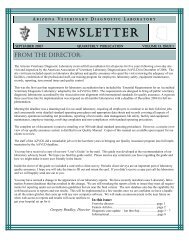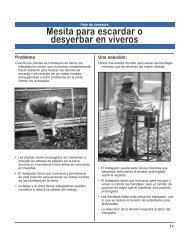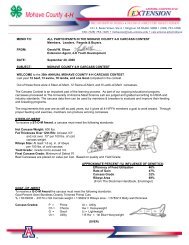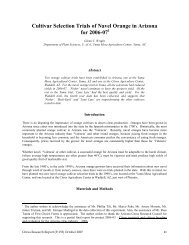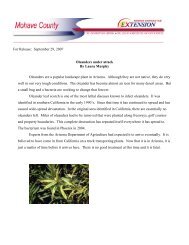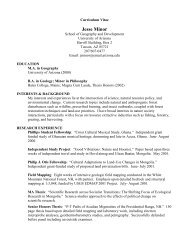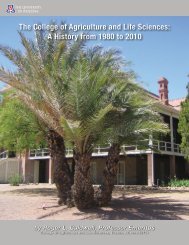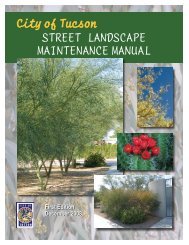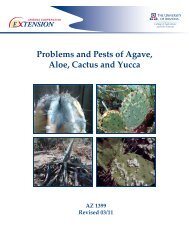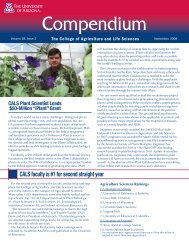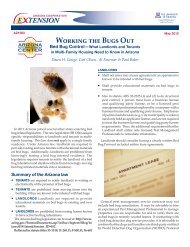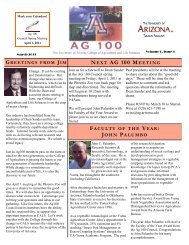Mesquite and Palo Verde Trees - University of Arizona
Mesquite and Palo Verde Trees - University of Arizona
Mesquite and Palo Verde Trees - University of Arizona
Create successful ePaper yourself
Turn your PDF publications into a flip-book with our unique Google optimized e-Paper software.
Parkinsonia praecox subsp. praecox (Sonoran palo brea, Brea)<br />
Figure 17: Leaf, flower <strong>and</strong> seed pod <strong>of</strong> Parkinsonia praecox<br />
subsp. praecox<br />
This small tree grows 15 to 30 feet (4.5 – 9 meters) tall<br />
with almost equal spread. This subspecies has the largest<br />
leaves <strong>of</strong> the genus (Fig. 17). Flowers are golden yellow,<br />
the bark is bright green to lime green with foliage <strong>of</strong><br />
blue green color. Seed pods are tan colored, oblong <strong>and</strong><br />
1.2 – 2.5 inches (3 – 6) cm in length <strong>and</strong> can create heavy<br />
litter. Growth rate is moderate to rapid <strong>and</strong> increases with<br />
supplemental irrigation. Plants tolerate a wide range <strong>of</strong><br />
soil conditions.<br />
Subspecies praecox is native to the widest range <strong>of</strong><br />
the genus <strong>and</strong> occurs from northwest Mexico in disjunct<br />
populations as far south as Argentina, <strong>and</strong> from near sea<br />
level to 6,560 feet (2000 meters) elevation. This subspecies is<br />
considered less tolerant to drought <strong>and</strong> cold temperatures<br />
than the subspecies glauca. Hardiness <strong>of</strong> plants from<br />
Sonora has been reported at 20 ºF (–7 ºC). Hybrids <strong>of</strong> P.<br />
praecox with P. microphylla or P. florida have been observed.<br />
Parkinsonia hybrids <strong>and</strong> cultivars<br />
Parkinsonia x ‘Desert Museum’ is the most popular<br />
hybrid <strong>of</strong> the genus <strong>and</strong> is a natural three- way cross <strong>of</strong> (P.<br />
aculeata x P. microphylla) x P. florida. Desirable horticultural<br />
characteristics <strong>of</strong> this tree include its upright growth habit,<br />
no thorns, fast growth with irrigation, smooth light green<br />
bark, <strong>and</strong> large masses <strong>of</strong> yellow flowers produced from<br />
March to May. Leaf size is intermediate between the parent<br />
taxa. P. x ‘Desert Museum’ has one or two pairs <strong>of</strong> pinnae<br />
8 The <strong>University</strong> <strong>of</strong> <strong>Arizona</strong> Cooperative Extension<br />
that are 2 – 4 inches (5 – 10 cm) in length <strong>and</strong> have 9 – 19<br />
pairs <strong>of</strong> leaflets per pinna. <strong>Trees</strong> reach a height <strong>of</strong> 21 to 25<br />
feet (7 – 8.3 meters) <strong>and</strong> grow as wide in canopy. The plant<br />
is hardy to 15 °F (–9 °C). Plants need to be propagated<br />
vegetatively to retain the characteristics <strong>of</strong> the parent tree.<br />
Figure18: Leaf <strong>of</strong> Parkinsonia x ‘Desert Museum’<br />
Figure 19: Leaf, flower <strong>and</strong> seed pod <strong>of</strong> Parkinsonia x sonorae



